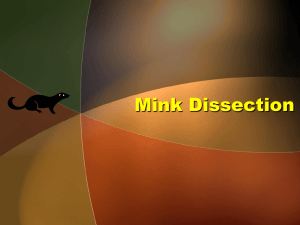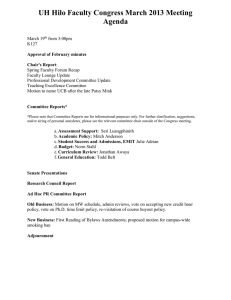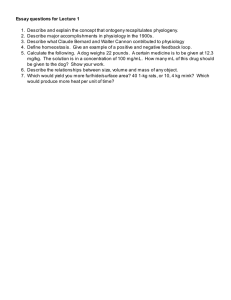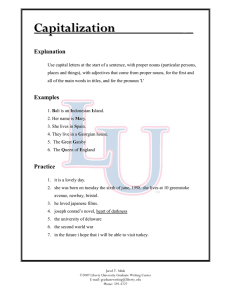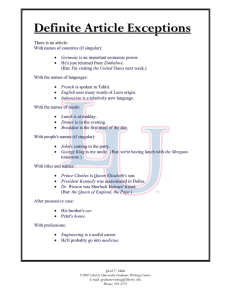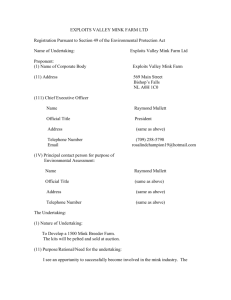Exceptional Sensitivity of Mink to the Hepatotoxic Effects of
advertisement
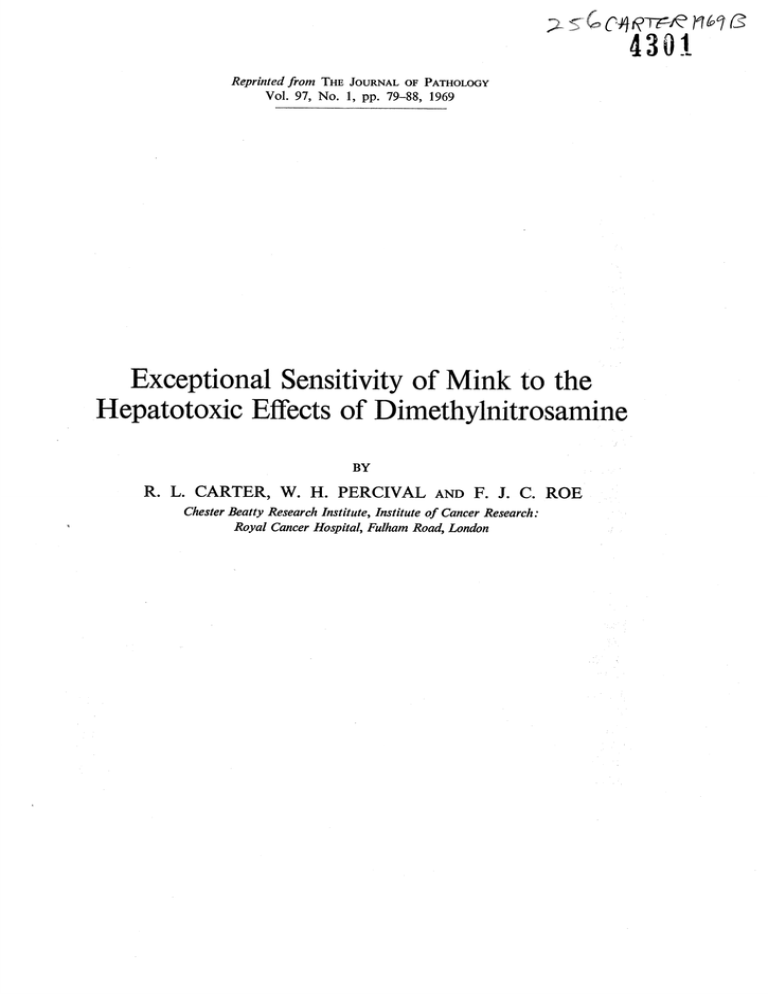
< c4R-T--r-R 067 4301 Reprinted from THE JOURNAL OF PATHOLOGY Vol. 97, No. 1, pp. 79-88, 1969 Exceptional Sensitivity of Mink to the Hepatotoxic Effects of Dimethylnitrosamine BY R. L. CARTER, W. H. PERCIVAL AND F. J. C. ROE Chester Beatty Research Institute, Institute of Cancer Research: Royal Cancer Hospital, Fulham Road, London EXCEPTIONAL SENSITIVITY OF MINK TO THE HEPATOTOXIC EFFECTS OF DIMETHYLNITROSAMINE R. L. CARTER, W. H. PERCIVAL AND F. J. C. ROE Chester Beatty Research Institute, Institute of Cancer Research: Royal Cancer Hospital, Fulham Road, London PLATES XXVII—XXX 1961, mink on certain fur farms in Britain died from severe liver disease accompanied by ascites and gastro-intestinal haemorrhage. A similar condition had not been encountered previously on the farms concerned and it soon became apparent that it was associated with the feeding of a particular brand of fortified mink food. It was later discovered that the start of the epidemic coincided with the incorporation in the food of a consignment of herring meal from Norway. IN The association between hepatotoxicity and the addition of Norwegian herring meal to the diet became significant in the light of reports from Norway of widespread deaths from a similar condition among mink, and also sheep and foxes, fed on diets containing herring meal. Described originally by Baler in 1960 and 1962, the toxic effects of herring meal were subsequently studied in detail by Koppang (1964, 1966), Koppang et al. (1964) and Koppang and Helgebostad (1966). Since the 1950s, it has been a common practice in Norway to preserve herring with an aqueous solution of sodium nitrite; occasionally, formalin is also added. Sodium nitrite retards the conversion of trimethylamine oxide, present in fresh fish tissues, to tri- and di-methylamine, a process which is catalysed by bacterial and autolytic enzymes (Ronald and Jakobsen, 1947; Hughes, 1959; Shewan, 1961; Tarr, 1961). But if sodium nitrite is added to stale fish, in which tri- and di-methylamines are already present, dimethylnitrosamine (DMNA) may be formed on subsequent heating when the herring are processed to produce meal (Ender et al., 1964). Some evidence that the toxin in herring meal is indeed DMNA was furnished by Ender et al., who identified this material in herring meal and showed that the toxic fraction, administered by stomach tube to mink, produced hepatic lesions similar to those encountered in field cases of herring meal intoxication. Later, Sakshaug et (1965) also identified DMNA in 'toxic batches of herring meal, demonstrated an association between its concentration and the severity of intoxication, and induced hepatotoxic effects by feeding sheep with a diet containing 30-100 p.p.m. DMNA. Nevertheless, these workers considered that their experiments were " not sufficiently extensive to allow definite conclusions to be drawn ". a The hepatotoxic effects of DMNA in mink are only briefly mentioned by and the only other information we have is from Dr W. Pearson, who Ender tells us that when he fed two mink on a diet containing 10 mg DMNA per kg (10 p.p.m.) they died in approximately 6 wk with extensive liver lesions similar to those described in animals exposed to toxic herring meal. This short survival suggested that mink might be much more sensitive to the acute toxic et al. Received 2 Apr. 1968; accepted 16 May 1968. 79 A2 80 R. L. CARTER, W. H. PERCIVAL AND F. J. C. ROE effects of DMNA than other species—young rats, for example, may survive for 26-40 wk on diets containing 50 p.p.m. DMNA (Barnes and Magee, 1954)— and a detailed study of the acute effects of DMNA on mink was therefore undertaken. MATERIALS AND METHODS Experimental animals. Twelve male mink were obtained from Mr David Ward of Bird's Eye Ltd, Great Yarmouth. The animals, all of the same " pastel " strain, were approximately 15 wk old and weighed between 1255 and 1425 g. They were divided arbitrarily into three groups. Mink 1-6 were fed on a standard diet alone. Mink 7-9 received a standard diet to which 2 . 5 p.p.m. dimethylnitrosamine (DMNA) were added. Mink 10-12 received a standard diet to which 5 p.p.m. DMNA were added. Standard diet. The percentage composition of the diet was as follows : fish offal 45.4; chicken offal 39 .0; cereal 10; liver meal 3 . 5; dried inactivated brewer's yeast 0 . 5; seaweed meal 10; vitamin supplements 0. 25; Aurofac 10 (which contains aureomycin) 0.04; ammonium chloride 0.03. Dimethylnitrosamine. DMNA, kindly supplied by Professor P. N. Magee, was diluted with distilled water to make a 1 in 1000 solution. For mink in the high-dose group, 5 ml of this aqueous DMNA solution was thoroughly mixed with 1 kg of the standard diet, and one-third of a kilogramme of the mixture was given to each animal daily. For mink in the low-dose group, 2 .5 ml DMNA solution was mixed with 1 kg of the standard diet. In the control group, 1 kg of standard diet was mixed with either 5 ml distilled water (3 animals) or with 2 . 5 ml distilled water (3 animals). Towards the end of the experiment the six control animals, which had grown continuously, required more than one-third of a kilogramme of diet on some days. Subsequent conduct of the experiment. The mink were housed singly in open wire-mesh cages in an unheated shed of which the windows were left permanently open. They were examined daily to assess their general condition and were weighed on 4 occasions—on the day before treatment with DMNA began, twice during the experiment, and once at death or when they were killed. The proportion of food consumed during the previous 24 hr was examined, and, for this purpose, food that anorexic animals had dropped on the floor was taken into account. Full post-mortem examinations were carried out on the test animals (all of which died) and on the control animals (which were killed by an intraperitoneal injection of Nembutal). Tissues were fixed in Bouin's solution and in formol-saline. Paraffin sections were prepared at 5 ium and stained with haematoxylin and eosin; paraffin sections of liver were also stained with haematoxylin and Van Gieson and with Masson's trichrome, and by Gordon and Sweets' silver impregnation method for reticulin fibres, Perls' method for iron and McManus' periodic acid-Schiff reaction for glycogen. In addition, frozen sections of liver were stained for fats with oil red 0. RESULTS Clinical and macroscopic observations When the mink arrived and were transferred to their new cages, they initially showed signs of distress and anxiety. These features were, however, transient, and the experiment began 24 hr after the animals were received. The 6 control mink (animals 1-6) remained in good condition throughout the 6 wk of the experiment. By the 9th day they were eating all (or almost all) the food allotted to them and, from the 22nd day onwards, it was necessary to SENSITIVITY OF MINK TO DIMETHYLNITROSAMINE 81 provide them with more than one-third of a kilogramme of the standard diet for each day. The 3 mink (animals 10-12) fed with the diet containing 5 p.p.m. DMNA began to sicken on the 7th, 1 1 th and 10th days respectively. By the 11th day, mink no. 10 was clearly ill with ruffled fur and noticeable loss of weight; by the 13th day, mink no. 11 and 12 had deteriorated in a similar manner. At first, food consumption was normal in all 3 animals, but fell below that of the controls between the 9th and 1 1 th days. After the 14th day the amount consumed was usually less than half of that offered (i.e., 333 g) and, during the few days before the mink died, they ate none at all or only a small fraction of the amount provided. Abdominal distension was noted in mink no. 10 and 11 on the 25th and 21st days respectively, and polydipsia was recorded in all 3 animals from the 22nd day onwards. During the last week of their lives, the animals ceased to pass solid faeces and two of them began to vomit blood or bile ; two of the three mink passed tarry stools on the day before they died. The three animals died on the 27th, 23rd and 28th days of the experiment respectively. A similar sequence of events occurred in mink fed with the diet containing 2 . 5 p.p.m. DMNA, except that it was observed over a more extended period of time. Loss of condition was first recorded in all 3 animals on the 1 1 th day. Consumption of food remained normal until the 10th day. Between the 10th and 24th days, the average amount of food eaten—though much less than in the controls—was greater than that consumed by mink that received 5 p.p.m. DMNA in their diet. After the 24th day, no food was eaten. Lack of solid it stools was noted in mink no. 8 and 9 on the 22nd and 23rd days respectively. On the 29th day, mink no. 7 and 8 vomited blood and, on the 24th day, mink no. 8 had tarry blood around the anus. The animals died on the 32nd, 34th and 32nd days respectively. The experiment was terminated by killing the 6 control mink between the 40th and 42nd days. Estimates of food consumption and of the cumulative dose of DMNA, together with observation on changes in body weight and on the general condition of the animals, are summarised in tables I and II. At necropsy, carried out within a few hours of death, mink exposed to DMNA were seen to be wasted and their fur was dull and rough. Abnormal features were confined to the abdomen. The liver was consistently smaller than in the controls, though the liver/body weight ratio was within normal limits. The surface was smooth and presented a dark red, mottled appearance; there was slight bile-staining. The portal vein and its major tributaries were normal. None of the animals was jaundiced. In 5 of the 6 animals (all except mink no. 7) blood-stained ascitic fluid was present, measuring 5, 11, 29, 30 and 37 ml. In 3 animals, the stomach and duodenum contained free blood, small blood clots (tending to adhere to the gastric walls) and bile, and similar material was found in more distal parts of the intestines. Some congestion and enlargement of the spleen was observed in 2 cases, but other organs were macroscopically normal. 82 R. L. CARTER, W. H. PERCIVAL AND F. J. C. ROE ›, 4-4 -z 1-4 CZ ^00 )-4 ,0 N't N mmm t---moo NNN °z1 133 0 ■-, ba 0 ›, cnV fa,:t4 C::1 E 0 00 • .-4 co E o o 475 E -44 in0 q— 42 U2 D o.,,,,-1 NNN mo NNN 0 0 44 "0 "0 0 4) 't1 0 d' d' ,....0,-(,--■ <4 VOZ rC 3 0 CI. " 4-) 0 ba 4... tl) 4-..,-.0 mo—E ,-, a E 0 = a A at e a:: 7) E menvILnino ,-1,-4,-1NNN coocoogitm,rmow, .4 ) ti) S. 0= 0 m ...-.....,.... n "Ci A'E '4' ,4".:t ..-4,-.1.-4 NV:..4-1r)oo0A 00000000 _ ,C) • --0To — at Ti 0 rt' 8 ,0 -0 Z w ..,,..to 000 ONCN,...-4 ,--1 E),ba 6 *„..-1,4 cA ca 0 4, 0 "" 0 W0 4, :Nr s tn :. t-- N NN : al',-"a noo • ONO\ NN . WIN •: >1-'5 1-4 T1 oomtnootr)smootO cT NNmcNINNtr) 00,-4,-INNN,tNt--moo ,t,".4-NrmmmNNN rn al 4,E +, cci 0E wc, cu (1) .2 o co cs o "t 4., cri c,1 N as "q 10 00 ....,-. oo Tit MT) 0 0 a:1 -o .., CA t-... 4. .al • ow -o 0 fai .. .. .. NN. 0 teZ 0 7, 7:, (I) 0 0 o .2 +ctIZ4-'0 '1-alb" 8c. E ot4-4 oo 0 000000v1ONN 0 NmNNteIV),-INt--V):N o0. CX) cg) co cg) kr) kr) kr) 0 CT e'4 ...1 o (.1 000001,101,11,10w10 00,-.4NW1/40MWINN CNIt ■10■0■00,--IN01001 v-..4 ,...1.-4,.......4 bn ..... p 5 .. .. .. . . . NNN NNN .....4,-.4.-4 .....1.-4,-.1 nC, o >1 C '1C e■4 1 ›, al ddd 66.6 6464. mmmn c-ievel r-...—I0 ddd 6466. 666. 000 .),;,,;1 = 0< 44 IllielvlirOw1001,10 41N ∎OvD,tNOttION000 en,tNNmmd-N.:1-.*md-------- dddddd "0 C.) C) .,.0 0t.. 00 C.) ,-4...■4,-- r-r-r-r--6.646.64 ---426.4ficL0.si0, , Intron000 NNNIntrf) c5 ci 71 •...,E c < +.0 N >> cd c,..,W0 0 .0 .0 CA E .4-1 ONN,1-,:t0■0‘00N0111 viDood-NCN,--oo CA0.-r.-00001t-(13∎ ..4 .-..,-...-., sooch o,....,c.1 ..,....,—, 0 rric —,c1m..tine-00c,0,-,N -E- -t CARTER, PERCIVAL AND ROE PLATE XXVII SENSITIVITY OF MINK TO DIMETHYLNITROSAMINE FIG. 1.—Liver of mink no. 10, after 27 days' exposure to 5 p.p.m. DMNA. There is widespread degeneration and necrosis of hepatocytes. Haematoxylin and eosin. x 320. FIG. 2.—Same liver as in fig. 1, stained for fat, showing marked fatty change. Oil red 0. x 320. CARTER, PERCIVAL AND ROE PLATE XXVIII SENSITIVITY OF MINK TO DIMETHYLNITROSAMINE FIG, 3. FIG. 4. FIGS. 3 and 4.—Same liver as in fig. 1. Advanced occlusive lesions in centrilobular veins. The surrounding parenchyma is degenerate and many hepatocytes are strikingly enlarged. Masson's Trichrome. x 300. CARTER, PERCIVAL AND ROE PLATE XXIX SENSITIVITY OF MINK TO DIMETHYLNITROSAMINE FIG. 5.—Liver of mink no. 12, after 28 days' exposure to DMNA. Early occlusive lesion in centrilobular vein. Periodic acid-Schiff. x 320. FIG. 6.—Same liver as in fig. 5. Portal tracts, showing congestion of portal vein and proliferation of bile-duct epithelium. Masson's Trichrome. x 320. CARTER, PERCIVAL AND ROE PLATE XXX SENSITIVITY OF MINK TO DIMETHYLNITROSAMINE FIG. 7.—Liver of mink no. 10. Thickening and condensation of argyrophil fibres around . x 400 partially occluded centrilobular vein. Sweets and Davenport's silver impregnation. SENSITIVITY OF MINK TO DIMETHYLNITROSAMINE 83 These changes were confined to animals exposed to DMNA and all tissues and organs from control mink were macroscopically normal. Histopathological changes in mink exposed to dimethylnitrosamine The principal histological abnormalities were found in the liver, in which the normal parenchymal pattern was completely obscured. In all zones, hepatocytes were either dead or degenerate and no residual foci of normal parenchyma remained. The liver cells were strikingly variable in appearance : many of them were strikingly enlarged and showed considerable pleomorphism in nuclear and cytoplasmic structure (figs. 1 and 3-5). The nuclear chromatin varied in arrangement from a fine, diffusely scattered pattern to coarse blocks of material lying either at the edge of the nucleus, close to the nuclear membrane, or more deeply. Intranuclear vacuoles and PAS-positive inclusions were sometimes present. The cytoplasm showed a variety of changes such as reduced basophilia, increased numbers of granules and massive accumulations of fat (fig. 2). No typical glycogen granules were demonstrable, but single large cytoplasmic bodies staining pale mauve with PAS were occasionally observed. Binucleate cells were sometimes seen, but, despite the remarkable size and pleomorphism of many of the liver cells, mitoses were rarely found. In some zones there was widespread necrosis of hepatocytes, such cells persisting as " ghost forms " in otherwise structureless masses. Extensive haemorrhages were present throughout the parenchyma, but were often most prominent near the centrilobular veins, in which striking changes were found (see below). The sinusoids were frequently disrupted by large pools of blood, but, in less damaged regions, cellular infiltrates could be made out within intact sinusoids. These were composed of polymorphs and mononuclear cells, some of which may have been Kupffer cells shed from the walls of the sinusoids. Erythrophagocytosis was occasionally noted. In addition to these parenchymal changes, widespread abnormalities were also seen in the hepatic veins (figs. 3-5). Many of the centrilobular and sublobular veins were occluded, in whole or in part, by cells and fibrinous material. Most of these veins were extremely difficult to identify in sections stained with haernatoxylin and eosin, but were relatively prominent with trichrome stains. The venous adventitia and media were considerably thickened, although individual muscle fibres were usually fragmented. Elastic fibres were invariably absent. Changes on the luminal side of the tunica media were difficult to evaluate, but varying proportions of four main types of cell were commonly present : spindle-shaped cells, thought to be intimal elements, polymorphs, macrophages and erythrocytes. In a few instances, large cells which appeared to be hepatocytes were seen in or near the lumen or centrilobular veins (fig. 5). The possible inward extension of liver cells in this fashion is surprising but by no means impossible in view of the considerable destruction of the vein walls (see In some instances, the veins were entirely solid and appeared as rings of connective tissue embedded in a mass of degenerate liver cells and extravasated blood. The portal veins were frequently congested but showed no occlusive lesions (fig. 6), and the hepatic arteries were normal. Discussion). 84 R. L. CARTER, W. H. PERCI VAL AND F. J. C. ROE Other hepatic changes included moderate proliferation of bile-duct epithelium and some bile stasis (fig. 6). There was no increase in periportal or interlobular fibrous tissue, although thickening and condensation of fibrous tissue were observed around occluded centrilobular and sublobular veins. The normal reticulin framework was distorted by the generalised intraparenchymal haemorrhage and degeneration, and, in particular, condensation of argyrophil fibres was noted around occluded veins (fig. 7). The hepatic capsule was unremarkable. Pathological findings in organs other than the liver were meagre. The kidneys from 5 animals showed fatty change in the epithelium lining the proximal convoluted tubules, and pancreatic islet cells appeared to be reduced in number in 2 animals. In 2 mink, acute gastric erosions were found involving the mucosal and submucosal layers. Tissues were carefully examined for signs 1963) but none was found. of aleutian disease (Leader All the changes described above were seen in mink exposed to DMNA at both dose levels and no morphological criteria for distinguishing animals from the two experimental groups emerged. et al., Histopathological changes in control mink, not exposed to dimethylnitrosamine Livers from control mink appeared normal. The hepatocytes were uniform in size and shape and contained abundant glycogen but little stainable fat. The sinusoids, hepatic blood vessels, bile ducts and reticulin framework were unremarkable. Other tissues examined were normal. Other observations In some animals, the protein content of the serum and ascitic fluid was determined. Blood was obtained at necropsy from 2 control mink (no. 1 and 2), from one mink fed with 2. 5 p.p.m. DMNA (no. 7) and from 2 mink fed with 5 . 0 p.p.m. DMNA (no. 10 and 12). The total serum protein levels in these 5 animals, estimated by the Kjeldahl technique, were 6 .9, 6 .6, 4 .5, 2 .2 and 1 .7 g per 100 ml. In mink no. 7, which was fed with 2 .5 p.p.m. DMNA, the low level was attributable solely to a deficiency of albumin ; in mink no. 10 and 12, both albumin and globulin were low. The protein content of the ascitic fluid was measured by the same method in mink 9, 10 and 12: the levels recorded were 1 .6, 1 .3, and 1 . 1 g per 100 ml. DISCUSSION The present work demonstrates the remarkable sensitivity of mink to the acute toxic effects of dimethylnitrosamine (DMNA), administered in the diet. Mink appear to be more sensitive than any other species so far tested, which include rats, mice, dogs, rabbits, guinea-pigs, hamsters, ducklings and sheep (Barnes and Magee, 1954; Butler, 1964; Tomatis, Magee and Shubik, 1964; 1965). Mink resemble the other species in that the acute toxic Sakshaug et al., SENSITIVITY OF MINK TO DIMETHYLNITROSAMINE 85 effects of DMNA are virtually confined to the liver ; the hepatic lesions recorded show some variation. Such differences are not easy to evaluate since several factors in addition to interspecies variation may operate. These include the age and sex of the experimental animal, its nutritional habits and hormonal status, the functional state of the liver and the dose and method of administration of DMNA. In mink, necrosis of parenchyma was widespread and the sharply demarcated centrilobular distribution, observed in many species, was not seen. In the hamster, however, parenchymal necrosis is sometimes generalised rather than centrilobular after treatment with DMNA (Tomatis No histological evidence of regeneration was found although there is no doubt that, in some species exposed to a single large dose of DMNA, the liver damage is reversible and the parenchyma can be fully restored (Barnes and Magee). Some of the hepatocytes observed in the mink were considerably enlarged and resembled those described in rats by Magee and Barnes (1956). The significance of such cells was uncertain : it seemed unlikely that they were all merely degenerate forms, yet, despite their often primitive appearance, mitotic figures were rarely seen. In addition to the parenchymal damage, occlusive lesions in the centrilobular and sublobular veins were an important feature. These vascular changes have not commonly been directly associated with DMNA, although they have been recorded in rats by McLean, Bras and McLean (1965) and in sheep by Sakshaug Such lesions are of great interest, although the cell types involved are difficult to identify, as elements derived from proliferating venous endothelium, inflammatory cells and possibly the liver cells themselves 4 (cf. Koppang, 1966) participate. The pathogenesis of the ascites and gastro-intestinal haemorrhages that were observed in the present experiment was not studied in detail. It is likely that the bleeding tendency was a consequence of hepatocellular failure, with decreased formation of normal clotting factors; other mechanisms such as increased fibrinolysis or defibrination may also have contributed. The absence of obvious distension of the portal vein and its tributaries suggests that portal obstruction was not an important factor either in relation to the gastrointestinal haemorrhages or to the production of ascites. The latter is particularly difficult to explain. Since it was not accompanied by pleural effusion or by subcutaneous oedema, hypo-albuminaemia cannot have been more than a contributory cause and it seems probable that the ascites arose by seepage of interstitial fluid and blood direct from the liver where they had accumulated as a result of hepatocellular damage and veno-occlusion. Gastro-intestinal haemorrhage and bloodstained ascites have frequently been reported in other species exposed to DMNA (Magee and Schoental, 1964; Sakshaug but their causal mechanisms do not appear to have been investigated. The combination of hepatic parenchymal and vascular lesions is striking, but is not specific for poisoning by DMNA. In particular, it is also seen in a number of species (including man) exposed to pyrrolizidine alkaloids (Davidson, 1935; Selzer, Parker and Sapeika, 1951; Bras and Hill, 1956; Schoental and Magee, 1957, 1959; Bull, Dick and McKenzie, 1958). It should, however, be et al.). et al. et al.) 86 R. L. CARTER, W. H. PERCIVAL AND F. J. C. ROE stressed that in species that have been extensively investigated, such as the rat, the lesions produced by closely related pyrrolizidine alkaloids differ in certain features. For example, Schoental and Magee (1959) studied 6 alkaloids and found that the incidence and degree of venous damage varied considerably. Under certain circumstances and in certain species, a similar combination of parenchymal and vascular changes may also be produced by aflatoxin (Asplin and Carnaghan, 1961 Loosmore and Markson, 1961 Roe and Lancaster, 1964), although the more usual morphological response consists of intense fatty change, infiltration by rather ill-defined " oval cells ", and bile-duct hyperplasia. In the case of DMNA and the pyrrolizidine alkaloids, the general consensus is that the primary lesion is parenchymal and that venous lesions, when present, 1965). are secondary (Schoental and Magee, 1957; Hill, 1960 McLean Although the common site of action is on the hepatocyte itself, it would obviously be fallacious to assume that the biochemical lesions induced by DMNA, pyrrolizidine alkaloids and aflatoxins necessarily affect the same processes. The biochemical effects of DMNA have been studied in detail and there is evidence to show that the substance acts on hepatic microsomes by depressing the rate of incorporation of amino acids into liver proteins (see Magee and Schoental). This may provide a clue to the variation in susceptibility of different species to DMNA : the activity of detoxifying microsomal enzymes varies considerably in different species (Remmer, 1965), and it is possible that the unusual susceptibility of the mink to DMNA may reflect an intrinsic defect—either relative or absolute—in such an enzyme system. Whatever the cause, this extreme sensitivity of mink could perhaps be exploited in future studies on the mode of action of DMNA—both as an acute poison and also as a carcinogen. The results obtained in the present study are similar to those described in the original experiments on mink exposed to Norwegian herring meal (Koppang, 1964; Koppang and Helgebostad, 1966). There 1964, 1966; Koppang is close agreement between the two sets of observations both in respect of the effects of DMNA observed during life and in the pathological changes found at necropsy. Additional, albeit circumstantial, support is thus provided for the view that the toxic principle in certain batches of herring meal is DMNA. That so potent a carcinogen may be formed in the course of a preserving process is a disturbing consideration, particularly as sodium nitrite is used in other circumstances, such as the preservation of meat. A related nitroso compound, diethylnitrosamine, has been identified in wheat flour (Marquardt and Hedler, 1966) and, although this has not so far been confirmed (Thewliss, 1967), it is clearly desirable that all preserving and similar processes that utilise nitrites should be carefully reappraised so that the possible formation of carcinogens such as DMNA can be excluded. et al., et al., SUMMARY Three mink fed with 2 . 5p.p.m. and three fed with 5 . 0 p.p.m. dimethylnitrosamine (DMNA) in the diet sickened after 7-11 days and thereafter became rogressively anorexic and wasted, with melaena., vomiting of blood and bile, p SENSITIVITY OF MINK TO DIMETHYLNITROSAMINE 87 and ascites. Mink that received 5 p.p.m. DMNA died after 23-28 days ; animals that received 2. 5 p.p.m. DMNA died after 32-34 days. Six untreated control mink remained healthy. Necropsy revealed pronounced wasting, dark discoloration and mottling of the liver, the presence of bloodstained ascites, and haemorrhages into the alimentary tract from gastric and duodenal erosions. The histological changes in the liver included widespread degeneration and necrosis of hepatocytes, many of which were considerably enlarged, and occlusion of centrilobular and sublobular veins. Congestion, haemorrhages, increased intracellular fat, infiltration of sinusoids by polymorphs and mononuclear cells and slight to moderate proliferation of bile-duct epithelium were also recorded. There was no evidence of parenchymal regeneration. These observations indicate that the mink is exceptionally sensitive to the acute hepatotoxic effects of DMNA, and draw attention to the possible dangers of the addition of nitrites to foodstuffs. We are indebted to Professor K. R. Hill and Professor P. N. Magee for opportunities to discuss this work; to Mr K. G. Moreman and members of the staff of the Photographic Department, Chester Beatty Research Institute, for the photomicrographs; and to Mr E. Woollard for technical assistance. The work was supported by grants to the Chester Beatty Research Institute (Institute of Cancer Research : Royal Cancer Hospital) from the Medical Research Council and the British Empire Campaign for Research, and by the Public Health Service Research Grant no. CA-03188 from the National Cancer Institute, U.S. Public Health Service. REFERENCES ASPLIN, F. D., AND CARNAGHAN, R. B. A. 1961 . BARNES, J. M., AND MAGEE, P. N. 1954 . BRAS, G., AND HILL, K. R. . . . 1956 . BULL, L. B., DICK, A. T., AND MCKENZIE, 1958 . J. S. W. H. . DAVIDSON, J. . . . . . ENDER, F., HAVRE, G., HELGEBOSTAD, A., KOPPANG, N., MADSEN, R., AND CEH, BUTLER, Vet. Rec., 73, 1215. Br. J. Ind. Med., 11, 167. Lancet, 2, 161. J. Path. Bact., 75, 17. 1964. Ibid., 88, 189. 1935. Ibid., 40, 285. 1964. Naturwissenschaften, 51, 637. L. HILL, K. R. . HUGHES, R. B. . KOPPANG, N. . !f KOPPANG, N., AND HELGEBOSTAD, A. . KOPPANG, N., SLAGSVOLD, P., HANSEN, M. A., SOGNEN, E., AND SVENKERUD, R. LEADER, R. W., WAGNER, B. M., HENSON, J. B., AND GORHAM, J. R. LOOSMORE, R. M., AND MARKSON, L. M. MCLEAN, ELIZABETH, BRAS, G., AND MCLEAN, A. E. M. MAGEE, P. N., AND BARNES, J. M. MAGEE, P. N., AND SCHOENTAL, REGINA . MARQUARDT, P., AND HEDLER, L. . 1960. Proc. Roy. Soc. Med., 53, 281. 1959. J. Sci. Fd Agric., 10, 431. 1964. Nord. VetMed., 16, 305. 1966. Ibid., 18, 205. 1966. Ibid., 18, 210. 1964. Ibid., 16, 343. 1963. Amer. J. Path., 43, 33. 1961. Vet. Rec., 73, 813. 1965. Br. J. Exp. Path., 46, 367. 1956. Br. J. Cancer, 10, 114. 1964. Br. Med. Bull., 20, 102. 1966. Arzneimittel-Forsch., 16, 778. 88 R. L. CARTER, W. H. PERCIVAL AND F. J. C. ROE . 1965. In Progress in liver disease, ed. by H. Popper and F. Schaffner, London, vol. II, pp. 111-113. 1964. Br. Med. Bull., 20, 127. ROE, F. J. C., AND LANCASTER, M. C. . 1947. J. Soc. Chem. Ind., Lond., 66, 160. RONALD, D. A., AND JAKOBSEN, F. . SAKSHAUG; J., SOGNEN, E., HANSEN, 1965. Nature, Lond., 206, 1261. M. A., AND KOPPANG, N. SCHOENTAL, REGINA, AND MAGEE, P. N. 1957. J. Path. Bact., 74, 305. 1959. Ibid., 78, 471. SELZER, G., PARKER, R. G. F., AND 1951. Br. J. Exp. Path., 32, 14. SAPEIKA, N. . 1961. In Fish as food, ed. by G. Borgstrom, SHEWAN, J. M. • • New York and London, vol. 1, pp. 487560. 1961. Ibid., vol. 1, pp. 639-680. TARR, H. L. A. . • . 1967. Fd Cosmet. Toxicol., 5, 333. THEWLISS, B. H. . TOMATIS, L., MAGEE, P. N., AND SHUBIK, 1964. J. Natn. Cancer Inst., 33, 341. P. REMMER, 9 H. !f 7f !f PRINTED IN GREAT BRITAIN BY OLIVER AND BOYD LTD. , EDINBURGH
